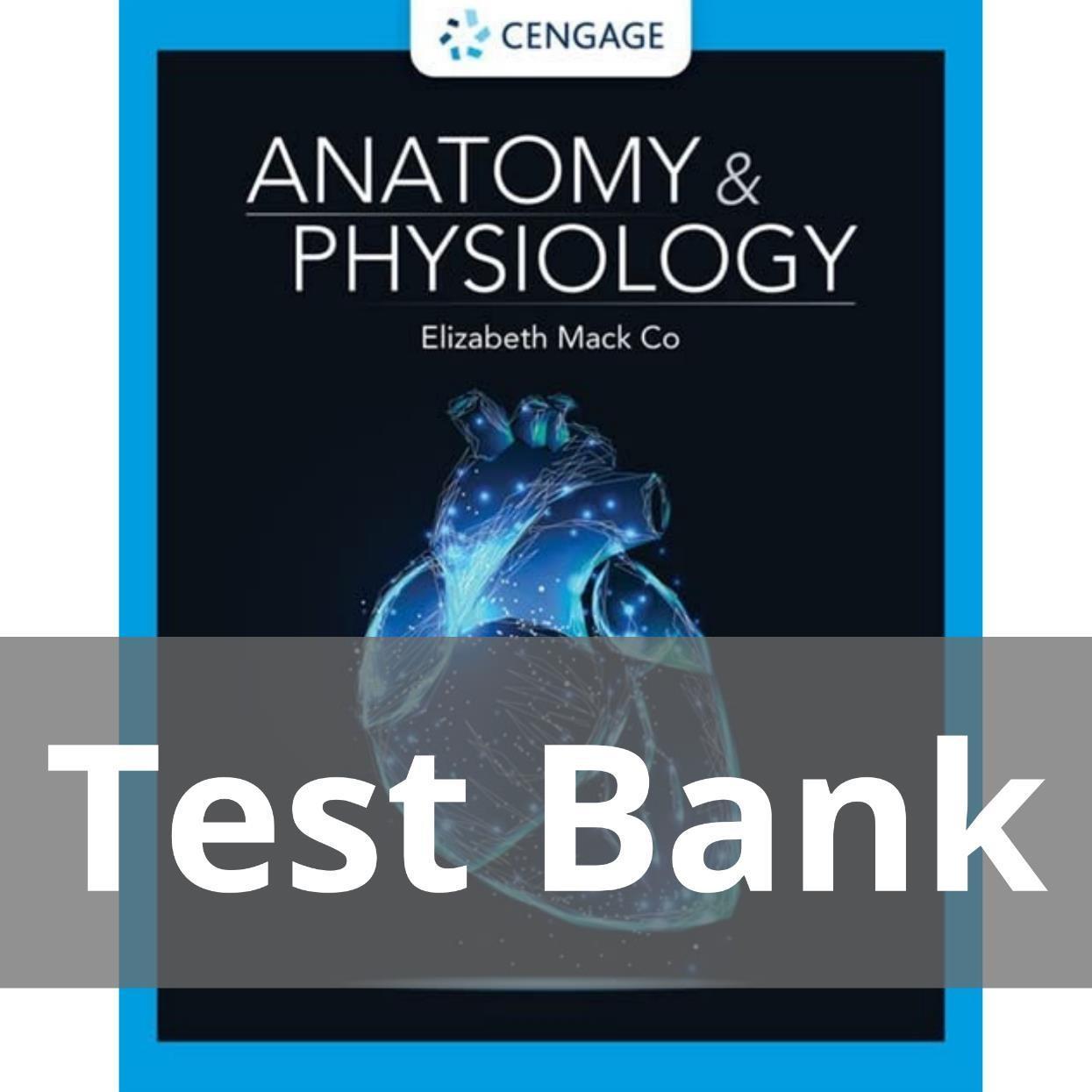Anatomy and Physiology 1st Edition by Elizabeth Co
Complete Test Bank
Download All Chapters Here: https://nursingrade.com/product/anatomy-and-physiology-1st-edition-byelizabeth-co-test-bank/

Multiple Choice
1. Which of the following definitions describes thescientific study of humananatomy?
a. The study of thebody’s metabolic functions.
b. The study of the body’s structures.
c. Thestudy of body’s chemical processes.
d. The study of the body’s molecular processes.
e. The study of the body’s evolution.
ANSWER: b
DIFFICULTY: Blooms: Remember
REFERENCES: 2.1 Overview of Anatomy and Physiology
LEARNING OBJECTIVES: 2.1.1 - Define the terms anatomy and physiology.
2. What two approaches doanatomists use to studythebody’s structures?
a. regional andsystemic
b. global and detailed
c. holistic and microscopic
d. internal and external
e. activeand passive
ANSWER: a
DIFFICULTY: Blooms: Remember
REFERENCES: 2.1 Overview of AnWaWtoWm.yTaBnS d M P. hyWsS iology
LEARNING OBJECTIVES: 2.1.2 - Give specific examples to show the interrelationship between anatomy and physiology.
3. Which of the following describes the study of regional anatomy?
a. The skin and its functions.
b. The interrelationships of all of the structures ina specific body region.
c. Human evolution by regions of the world.
d. The specific functions of an organ.
e. Chemical changes inthe human body.
ANSWER: b
DIFFICULTY: Blooms: Remember
REFERENCES: 2.1 Overview of Anatomy and Physiology
LEARNING OBJECTIVES: 2.1.2 - Give specific examples to show the interrelationship between anatomy and physiology.
4. Which of the followingdescribes the study of systemic anatomy?
a. The operation of body functions.
b. The sequence of chemical reactions inthe body.
c. The structures that makeup a discrete body system.
d. The evolution of the human body.
e. The changes inthe body over time.
ANSWER: c
DIFFICULTY: Blooms: Remember
REFERENCES: 2.1 Overview of Anatomy and Physiology
LEARNING OBJECTIVES: 2.1.2 - Give specific examples to show the interrelationship between anatomy and physiology.
5. What is phosphorylation?
a. The most common form of molecular regulation in animal cells – the addition of a phosphate group to specific molecules.
b. The ingestion andabsorption of excessive phosphorus from the environment.
c. The production of excessive amounts of phosphorus by the body.
d. The conversion of phosphorus through a series of reactions inthe environment.
e. The removal of phosphorus from our bodies.
ANSWER: a
DIFFICULTY: Blooms: Remember
REFERENCES: 2.2 Structure and Function
LEARNING OBJECTIVES: 2.2.1 - Describe, compare, and contrast various structure-function relationships from molecular to organ level.
6. Early humans evolved a restructured pelvis to accommodate for what specific function?
a. increasedintelligence
b. bipedalism
c. childbirth
d. self defense
e. sense of smell and taste
ANSWER: b
DIFFICULTY: Blooms: Remember
REFERENCES: 2.2 Structure and Function
LEARNING OBJECTIVES: 2.2.2 - Relate the commonly found branching structure to function of an organ.
7. How is human evolution defined?
a. The impact of the earth’s climate on human development.
b. Changes in human intelligence over time.
c. The development of cognitiveand motor skills over time.
d. Achange in gene expression that occurs from generation to generation.
e. The ability to adapt to constantly changing environments.
ANSWER: d
DIFFICULTY: Blooms: Remember
REFERENCES: 2.3 Evolution and Human Variation
LEARNING OBJECTIVES: 2.3.1 - Define the term and explain the concept of evolution.
8. Why does the body require UV radiation from sunlight?
a. To control the spread of bacteria.
b. To improve skin toneand quality.
c. For theproduction of proteins.
d. To control blood flow.
e. For thesynthesis of vitamin D.
ANSWER: e
Download All Chapters Here: https://nursingrade.com/product/anatomy-and-physiology-1st-edition-by-elizabeth-cotest-bank/
DIFFICULTY: Blooms: Remember
REFERENCES: 2.3 Evolution and Human Variation
LEARNING OBJECTIVES: 2.3.2 - Contrast the impact of selection on traits that affect reproduction and traits that do not; use this to explain examples of anatomical and physiological variation.
9. UVradiation from sunlight is harmful tofolate (folic acid) structure, a vitamin. What is a reason folate is essential?
a. It is essential for skin cell growth and development.
b. It is essential for single cell growth and muscular strength.
c. It aids insperm production and embryonic development.
d. It is important for eye sight and night vision.
e. It is involved with digestion.
ANSWER: c
DIFFICULTY: Blooms: Remember
REFERENCES: 2.3 Evolution and Human Variation
LEARNING OBJECTIVES: 2.3.2 - Contrast the impact of selection on traits that affect reproduction and traits that do not; use this to explain examples of anatomical and physiological variation.
10. What arethethreetypes of gradients that drive flow in a physiological context?
a. high, medium, and low gradients
b. elevated, standard, andreduced gradients
c. organic, inorganic, andchemical gradients
d. concentration, electrical, andpressuregradients
e. kinetic, dynamic, and static gradients
ANSWER: d
DIFFICULTY: Blooms: Remember
REFERENCES: 2.4 Flow
LEARNING OBJECTIVES: 2.4.1 - Describe how a gradient determines flow between two regions, and give examples of gradients that exist in different levels of organization in the body.
11. What type of gradient drives the flow of fluids andgases?
a. concentration gradients
b. electrical gradients
c. pressuregradients
d. organic gradients
e. gravitational gradients
ANSWER: c
DIFFICULTY: Blooms: Remember
REFERENCES: 2.4 Flow
LEARNING OBJECTIVES: 2.4.2 - Predict how changes in a gradient will affect flow rate.
Download All Chapters Here: https://nursingrade.com/product/anatomy-and-physiology-1st-edition-byelizabeth-co-test-bank/
